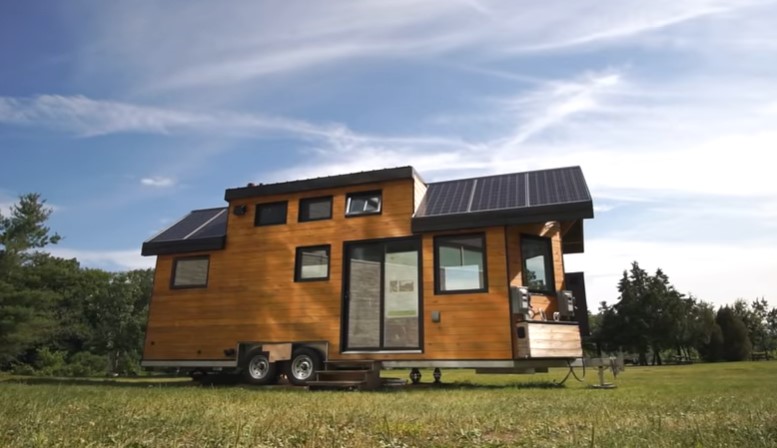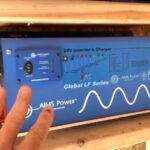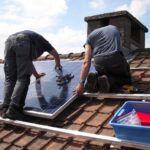Are you on the lookout for solar panels for tiny houses? Then you are in the right place. When you are new to a green lifestyle and wish to transition to go solar, it might feel like you are stepping into a foreign land. To help you in the right direction, we’ll be telling you about solar panels for tiny houses and more.
Tiny living isn’t for everyone; however, if you’ve chosen to live tiny, then you’ll find that a solar panel system is an eco-friendly and cost-effective option. Making a living in tiny homes requires lots of creativity; however, tiny houses and solar panels go hand in hand because the smaller space makes for low power needs.
Tiny homes are all about optimization, simply put, tiny houses are all about creating a simple, more efficient living space which is why solar panels and tiny homes go along. If you search for the best solar panels for tiny houses, continue reading and get inspired by the following options. Feel free to choose one that suits your needs.
Solar Panels for Tiny Houses FAQs
Are Solar Panels for Tiny Houses worth it?
The benefits you’ll reap from installing solar panels on a tiny house are similar to the benefits of installing on any other larger building: you’ll save money on electricity bills, help protect the environment, and take control of your electricity generation. Solar panel systems will also help increase the value of your tiny house should you decide to sell it in the future.
Additionally, many tiny houses are mobile, moving from various plots of land over time. If you have or are planning to build a tiny house on wheels, solar power is the way to go.
Why should you consider Solar Panels for Tiny Houses?
Tiny houses are a great candidate for solar power because the smaller space makes for low power needs. While the traditional home in America uses around 30 KWs per day, my tiny house uses about 3 KWs per day.
How much power does a tiny house use?
A tiny house will use around 4 KWs per day. Typically, approximately 80% of that power will be used for heating and cooling, assuming you cook and heat water with propane or natural gas.
Can you power a tiny house with solar panels?
Even tiny houses with low electricity needs can benefit from solar power. If your tiny home uses only a little bit of electricity and you only need a few solar panels to meet your needs, it’s often most cost-effective to do a DIY solar panel installation.
How much are solar panels for a tiny house?
After solar tax credits, the cost for a solar panel system on an average-size house in the U.S. ranges from $11,144 to $14,696, according to EnergySage. If you need a few panels for a small DIY project, expect to pay around $200 to $250 per panel (around $1 per watt).
How many solar panels do you need to power a tiny house?
Fifteen solar panels will power a typical tiny house. This assumes an average-sized solar panel of around 300 watts, which would generate around 4,500 watts of power from the sun. This would cover all your power needs, including some heating and cooling, but require you to have a gas cook range and a propane heated water heater. If you live in a particularly cold climate, you’ll most likely need to supplement your heating with a propane heater too.
How many solar panels can you fit on a tiny house roof?
Generally speaking, you can only fit around two solar panels on a tiny house roof. This presents a real challenge because today, you can only expect to make around 20 watts per square foot of solar panel in ideal circumstances. That means you’re only going to be able to fit around 600 watts of solar production on a tiny house roof, which isn’t a whole lot.
What you should know about mounting Solar Panels for Tiny Houses:
- Tiny house roofs only have around 200 square feet of space, and since most roofs are pitched, you can only mount panels on one side. This means you only have about 100 square feet of space for panels.
- Most tiny homeowners mount panels on stands on the ground after considering all the options: roof-mounted, pole-mounted, solar trackers, and fixed ground mount.
- The benefits of a ground-mounted array are huge: being able to easily clean your panels, clear off the snow that covers the panels after a snowfall, keep the panel’s cooler (increases their efficiency), and be able to shade your house while placing the panels in an open field.
- The most significant benefit of ground mounting solar panels has a way bigger solar panel array. This means instead of 600 watts on the roof of your tiny house, you could put 4,000 watts on the ground in the field right next to your tiny house.
- Many companies sell complete solar kits (such as those from Grape Solar or Reongy). Many sellers offer batteries as part of a solar kit if you’re looking to install an off-grid system. As with any electrical work, it’s a good idea to work on the project with an experienced electrician if possible.
- Alternatively, suppose your tiny home uses enough electricity to require more than 3 kilowatts (kW) of solar power. In that case, you should consider working with a solar installer that can assist with the work.
What to ask yourself before choosing Solar Panels for Tiny Houses?
What are my energy needs?
This is the most critical question to ask yourself before going solar. The size of your solar system depends on the amount of electricity you use or plan to use every month.
Where will your panels go?
- On the ground: By far, the most common option for tiny homeowners is an array of solar panels mounted on the floor. This is called, unsurprisingly, a ground-mounted system.
- On the roof: When most people think of solar, they picture the panels on a roof. Roof mounting is classic and looks cute, but it only makes sense for a small number of folks for tiny homeowners. How does a DIY Solar Panel Roof Mount sound if you are looking to reduce expenses?
- On the road: If you’re going to be completely mobile, designing your tiny home to go anywhere and everywhere with you, you’ll need a solar solution that you can move securely.
What are your goals?
- Independence: If you’re going tiny, you’re interested in downsizing your life, the amount of stuff you own, your footprint on our green Earth, as well as your cost of living.
- Saving Money: If your tiny home is in an urban or residential area, perhaps on the property of a larger home, you might want to consider trying your solar system into the grid and selling them the electricity you are creating.
Solar Panels for Tiny Houses
1.32kW Off-Grid Tiny House Solar Power System
This off-grid solar power system kit provides nearly everything you need to bring 1.32kW of off-grid solar power and storage to a tiny house off the grid.
The inverter/charger at the heart of this system is a Samlex EVO-2224, capable of delivering 2.2kW continuously over 120-volt pure sine wave AC output. As a 24V battery bank charger, the EVO-2224 offers adaptive 3- or 4-stage charging with equalization.
And with two programmable AC inputs, a generator can easily be added to this system. Working in tandem with the EVO-2224 is a FLEXmax 60 MPPT Charge Controller from OutBack Power, which provides up to 60 amps of 5-stage battery charging from your solar panels.

Features:
- Samlex EVO-2224
- 120-volt pure sine wave AC output
- 24V battery bank charger
1.98kW Off-Grid Tiny House Solar Power System
This off-grid solar power system kit provides nearly everything you need to bring 1.98kW of off-grid solar power and storage to a tiny house off the grid.
The inverter/charger at the heart of this system is a Samlex EVO-4024, capable of delivering 4kW continuously over 120-volt pure sine wave AC output.
As a 24V battery bank charger, the EVO-4024 offers adaptive 3- or 4-stage charging with equalization. And with two programmable AC inputs, a generator can easily be added to this system.
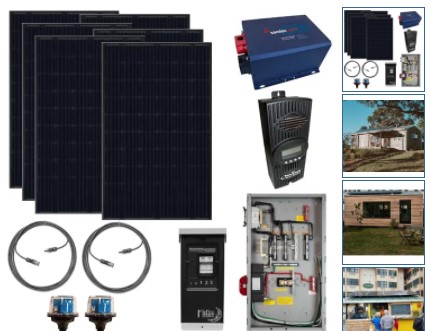
Features:
- Samlex EVO-4024
- 120-volt pure sine wave AC output
- 24V battery bank charger
660W Off-Grid Tiny House Solar Power System
The inverter/charger at the heart of this system is a Xantrex Freedom XC 1000, capable of delivering 1000W continuously over 120-volt pure sine wave AC output and handling short surges up to 2000W, so even loads with demanding startup requirements – like a refrigerator – can be accommodated.
As a 12V battery bank charger, the Freedom XC 1000 offers programmable smart battery management logic to help your batteries last longer, and it can charge dead batteries at 0 volts.
Whether in invert or charge mode, it delivers total output even in harsh temperature conditions from -4°F – 104°F.
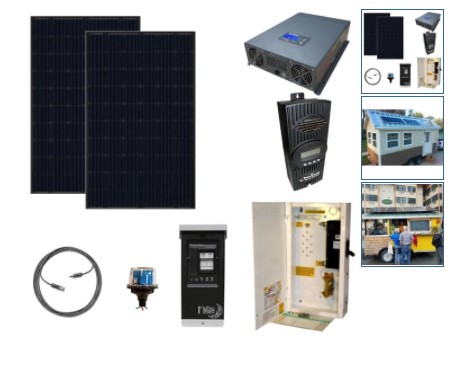
Features:
- Freedom XC 1000 Inverter/Charger
- 4x PV cable clips
- 1x 30′ MC4 connector cable
Mount Solar Panel Kit for RV or Tiny House
Charges most types of 12-volt batteries, including lithium; Expandable up to 1020 watts.
Included 60-amp charge controller with remote LCD monitors and protects batteries and panels
Kit includes 6 x 170-watt panels (single panel: 58.3 inches x 26.4 inches x 1.5 inches) plus. 60-Amp controller, remote display, wiring harnesses, 2 x 3-port roof caps, fuse block, mounting feet.

Features:
- 1020 watts
- 60 Amps
- 12 Volts

